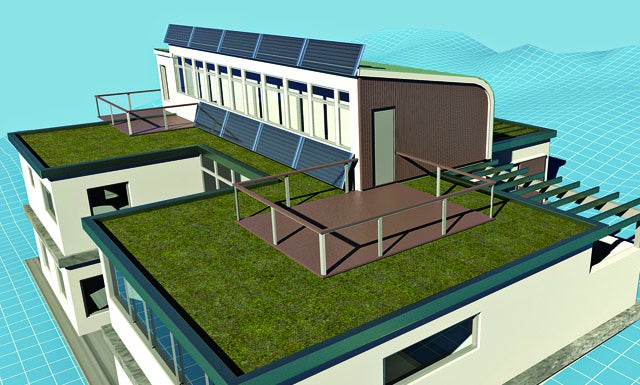Green Dream: Custom-Made Aluminum Windows Save Money and Energy
Plus: four more green windows and doors for retrofitting your own home

With the efficient pre-fab panels that make up the walls of my home, it’s vital that I don’t let all the heat—and my budget—escape out my 47 windows. So the fact that I had my heart set on sleek aluminum frames instead of wood or vinyl posed some challenges.
Residential aluminum windows tend to be inefficient because metal is far more conductive than wood, allowing significant heat loss, so they’re mostly used in warmer climates. Commercial models use thicker frames with a strip of insulating resin as a thermal break between the interior and exterior. But the extra materials and complicated design raise the price, and commercial makers aren’t set up for small residential orders. I got an astonishing quote of $137,000 for a mix of casement, fixed and slider models.
Then my architect found Tom Gordon, who runs a 16-person custom window-making shop in Rhode Island. Gordon has been designing an affordable, efficient residential aluminum model—the
Biltite Evolution—for the past two years.
His frames use four insulating techniques: two types of plastic thermal breaks, air pockets to help prevent condensation and three panes of glass with argon trapped between them. Since these don’t need to be as robust as commercial windows, Gordon uses thinner-walled aluminum, which keeps the price down, and dealing directly with the manufacturer (Gordon) cuts out the standard distributor markup. My total bill is around $55,000.
A simulation of the window design run by an independent testing lab showed that it would be 50 percent more efficient than a vinyl window, with a U-value (a measure of how well it conducts heat) of 0.21, low enough to qualify for an energy tax credit.
Next up: Turning the roof into a living room.
The Specs
House: 3,500-square-foot, four-bedroom contemporary
Location: Greenwich, N.Y.
Project: Install energy-efficient aluminum windows
Cost: $55,000
Time to install: About a week
Eco-advantage: Less heat loss than standard aluminum or vinyl windows

What’s Inside Biltite Evolution Windows?
Already have a home?
Four More Green Windows and Doors
- Clean Caulk
Sealing air leaks with caulk is the easiest way to reduce energy costs—up to 20 percent on heating and cooling bills. And now you can do it without trapping noxious volatile organic compounds (VOCs), with Smart zero VOC rubberized caulk, the first made without headache-inducing chemicals. $2.39; gardner-gibson.com - Eco-Door
Champion’s steel-and-fiberglass doors are the first to earn Green Seal certification, which evaluates a product’s manufacturing and life cycle. The company ensures that its materials have no lead or mercury, coats the door with low-VOC paint, and recycles its own scrap metal and water during production. From $1,500; championwindow.com - UV-Free Window
Huper Optik’s Ceramic 30 window film deflects up to 70 percent of the sun’s heat, helping to cool the home while blocking nearly all ultraviolet rays, which can fade furniture. The film is embedded with NASA-developed titanium nitride beads that block UV and infrared light, but let visible light through. From $7 per square foot; huperoptikusa.com - Greenest Glass
Soon your windows could double as solar panels. RSi’s 60-percent-transparent photovoltaic-embedded glass can produce about 36 watts from a typical three-by-four-foot window in direct sunlight and can be electronically frosted. It’s being tested on commercial buildings in California and could trickle down to homes as early as 2011. solar.tm
John B. Carnett, PopSci’s_ staff photographer, is using the latest green technology to build his dream home. Follow along as the project progresses on his Green Dream blog: popsci.com/green-dream_